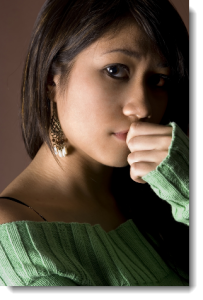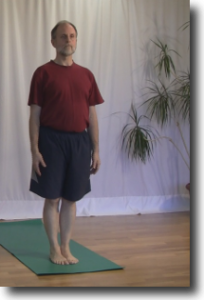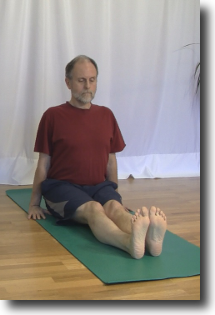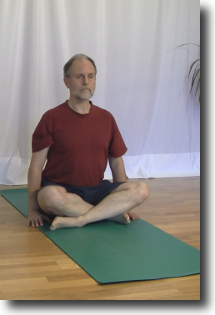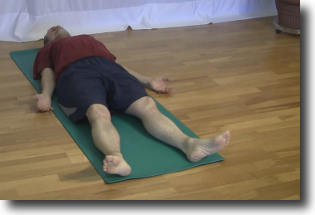Alice is going to try yoga. She has been hearing so much about how good yoga is so for you, but she is anxious about learning yoga.
It’s a new place with people she does not know and they do strange things there like stand on their head and put their legs in strange places. Alice is concerned that she will be lost, look stupid or maybe even hurt herself.
She talked to Carol, a friend of hers that was already practicing yoga, about her concerns. Carol assured her that yoga is not all that bad. Some of the poses that Carol does during a yoga class are quite familiar.
She went on to show Alice four poses that she was already knew how to do before she went to her first class.
These are the four poses that Carol showed Alice:
- Tadasana – Standing up
- Dandasana – Sitting down
- Sukhasana – Sitting with legs crossed
- Savasana – Laying down
Carol started with the easiest one of all Standing up.
Standing on your own two feet pose
This is one of the simplest yoga poses. Its name is Tadasana which translate from Sanskrit as Mountain pose.
In this pose you are standing tall with your toes touching and a slight gap between your heels. You lift your ribs, lengthening your spine and drop your shoulders down your back. With your arms resting at your side you gaze to the horizon and centre your weight over your feet.
The 4 poses Alice already knows are:
– Standing up
– Sitting down
– Crossed legs
– Laying down
You do this pose a lot everyday in real life and you do this pose a lot in a yoga practice.
All standing yoga poses start from Tadasana so it is a good thing that Alice is already familiar with this one. This is the only standing pose that Carol showed Alice. Carol then went on to show Alice a couple of seated poses that she already knew starting with sitting on the floor.
Sitting down with legs out front pose
In this pose Carol sat on the floor with her legs out in front of her. Carol told Alice that this pose is know as Dandasana which is Sanskrit for Staff pose.
Just like Tadasana is the beginning point for the standing postures, Dandasana is the starting point for most seated postures.
You come to the floor sitting with your legs straight out in front of you. Your feet point up to the ceiling with your big toes touching and a slight gap between your heels and your knees turned inward slightly. Your torso is rising straight up towards the ceiling and your hands are resting lightly on the floor beside your hips with your fingers pointing towards your toes. And finally you tuck your chin in slightly and you gaze towards your toes.
This seemed like another very simple pose to Alice. She was certain that she could do this pose. She even gave it a try while Carol was describing and demonstrating how to do it.
This yoga stuff was not so scary and strange after all. But Carol was not done showing her yoga poses. The next pose that Carol showed Alice was a variation on Dandasana. Carol crossed her legs.
Sitting down with legs crossed pose
Sukhasana is the Sanskrit name of the yoga pose where you sit on the floor with your legs crossed. The Sanskrit name means Easy sitting and this pose is really easy to do.
You sit on the floor and cross your legs at the shins, letting your knees descend towards the floor. You keep your spine tall with your shoulder blades descending down your back. Bring your palms to your knees and drop your gaze towards the floor a few feet in front of your legs.
Alice followed Carol’s movements and was able to do Sukhasana quite easily. She was gaining confidence that yoga was not all that scary.
Carol was saving the best pose for last. This one is dead simple to do. In fact its name is Corpse pose.
Laying down pose
Savasana is the Sanskrit name of this pose, which translates as Corpse pose. You do this pose at the end of your yoga practice as you enter into the meditation time.
It is important in this pose that you get the entire body into a neutral position. You begin by laying on the floor with your arms and legs together, then you let your legs relax and your feet will naturally fall outward and away from each other. Next you move your arms about a hand width or so away from your body with your palms facing upwards towards the ceiling. Your shoulders will tell you when you have moved your hands far enough away from your body. Now you bring your awareness to the muscles of your back. Move your hips and shoulders until all of the muscles of your back are in a neutral position and relaxed.
The most challenging aspect of Savasana is controlling your mind. The challenge is to keep your mind focused on the present moment and to stay with your body rather than moving to the future or past.
Carol was right, Alice thought, this pose is dead simple. In fact she could stay here for a long time.
Summary
Alice and Carol finished their short yoga class and Alice is feeling a lot more confident about going to her first real yoga class.
Standing up, Sitting down, Crossing your legs and laying down are all very easy and familiar yoga poses.
Alice is surprised about how many yoga poses she already knew and now she is ready for her first yoga class.
Next Steps
Try these poses out before you go to your first yoga class and you will be more confident when you enter the yoga studio for the first time.
Additional Reading
To learn more about getting the maximum benefit from Tadasana or Mountain pose have a look at How to do Tadasana.
Why the Baby Toe factor is so important in Dandasana shows you how to get the most out of Dandasana when you have short hamstrings.
Why Savasana is so simple and yet so difficult explains the mentally challenging aspects of Corpse pose.

